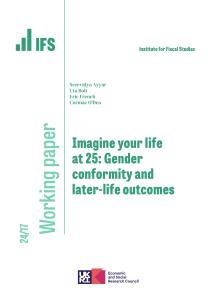While employment and earnings in Scotland grew substantially faster than in the rest of the UK (rUK) during the 2000s, since 2014 Scotland has seen slower growth. In 2014 the employment rate in Scotland was 1 percentage point higher than in rUK (74.0% versus 73.0%), but by 2021 it was around 1 percentage point lower (74.7% versus 75.5%). And while average monthly earnings grew by almost 5% in real terms (i.e. after accounting for inflation) between 2015 and 2022 in rUK outside of London, they grew by just 1.5% in Scotland.
A new report by IFS researchers shows that this recent relatively weak performance has been driven by a marked deterioration in employment and earnings levels in the Highlands, Islands and North East of Scotland – areas which have historically had relatively strong labour market outcomes.
- The employment rate in the Highlands and Islands and the North East of Scotland fell by around 3 percentage points between 2013–15 and 2020–22. In contrast, employment in the rest of Scotland increased – by 2 percentage points in the South of Scotland, and 3 percentage points in the East of Scotland and West Central Scotland, where it has broadly kept pace with trends in rUK.
- Average monthly earnings in the North East of Scotland fell from 30% above the rUK average outside of London in 2015 to 14% above in 2022, while those in the Highlands and Islands fell from 6% below to 10% below over the same period. In contrast, mean monthly earnings in East, South and West Central Scotland grew at almost the same rate as those in rUK outside of London.
The deterioration in labour market performance in the Highlands, Islands and North East of Scotland in recent years is likely driven, at least in part, by a decline in employment and earnings in the oil, gas and related sectors – high-paying sectors concentrated in these areas of Scotland.
However, despite the recent deterioration in performance, the employment rate in the Highlands, Islands and North East (75% in the period 2020–22) remains above the Scottish average – and substantially higher than in the West Central region surrounding Glasgow (71% during the same period). In addition, average monthly earnings in North East Scotland remain well above the level in the rest of Scotland – and indeed most of the rest of the UK.
Other notable findings in the report include that:
- The lowest average earnings in Scotland are found in rural areas of Central and South Western Scotland, but more generally, rural areas of Scotland perform relatively well in terms of earnings compared with those in rUK. For example, among low-population-density council areas (those with fewer than 100 people per square kilometre) across the UK, Scottish councils make up 6 of the 10 with the highest average hourly earnings (Stirling, Aberdeenshire, Orkney Islands, Perth and Kinross, Shetland Islands and South Ayrshire), but only 1 of the 10 with the lowest average hourly earnings (Dumfries and Galloway).
- Average household disposable income per person – which includes income from pensions, investments and benefits, as well as earnings – is below the rUK average in nearly all Scottish council areas, the exceptions being Aberdeenshire, Edinburgh, East Dunbartonshire, East Renfrewshire, East Lothian and Shetland. But this is largely due to high incomes in the South of England pulling up the rUK average: almost all Scottish council areas have higher average income per person than the average in rUK excluding the South of England.
These findings show that despite a decline in labour market performance in the Highlands, Islands and North and a stalling in earlier improvements compared with rUK in other parts of the country, employment, earnings and household incomes in Scotland perform well compared with the Midlands and North of England, and especially Wales and Northern Ireland.
David Phillips, an associate director at the Institute for Fiscal Studies and one of the authors of the report, said:
‘The complex regional patterns and trends in employment and earnings pose something of a policy conundrum for the Scottish Government, especially given the limited funding it has available.
‘On the one hand, it is likely to face political pressure to provide additional support to the North of Scotland to help make up for reductions in employment and earnings associated with the decline in the oil and gas industry. Moreover, it will want to keep the – often highly skilled and highly paid – workers from these sectors in Scotland, not least given the outsize contribution their earnings make to supporting local economies and devolved tax revenues.
‘On the other hand, it remains the case that the areas with lowest earnings and employment are concentrated in Central and South Western Scotland, despite improvements in performance in some of the more deprived areas around Glasgow in recent years.
‘This may suggest focusing general support for skills, employability and economic development on the traditionally struggling areas of Scotland, but providing targeted interventions to help workers in the oil, gas and other sectors to take up other opportunities in Scotland (for instance, related to the green energy transition).’








